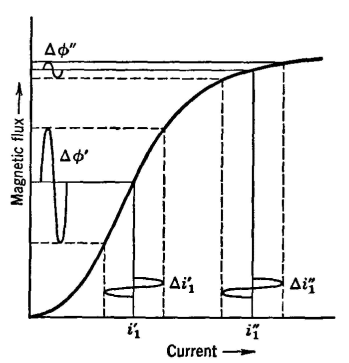| Electrical Communication is a free textbook on the basics of communication technology. See the editorial for more information.... |

|

Home  Electrical Fundamentals of Communication Electrical Fundamentals of Communication  Self-Inductance Self-Inductance |
|||






|
|||
Self-InductanceSelf-inductance is defined1 as "the (scalar) property of an electric circuit which determines, for a given rate of change of current in the circuit, the electromotive force induced in the same circuit. Thus
where e1 and i1 are in the same circuit, and L is the coefficient of self-inductance.'' In this equation e1 is the instantaneous induced electromotive force in volts, L is the self-inductance in henrys, and di1/dt is the instantaneous rate of change of current in amperes per second. The magnitude of the instantaneous induced electromotive force is e1 = N dφ1/108dt. If this is substituted in equation 2, the magnitude of the self-inductance becomes
Communication equipment such as coils and transformers often have closed cores of ferromagnetic material. Also, coils sometimes have direct-current and alternating-current components flowing simultaneously in the windings. The inductance of such units can be found by equation 3, assuming that the magnetic characteristics of the material are known. This is shown by Fig. 1 which illustrates the way in which the magnetic flux φ varies in a ferromagnetic core with the current i1 that produces it. Suppose that the value of the direct-current components is i1' and that the alternating-current component is as shown by Δi1'; then, the corresponding flux change will be Δφ'. Hence, dφ1/di1 of equation 3 will have a certain value, and the self-inductance L a certain magnitude. Now suppose that the value of the direct-current component i1'' is different from i1', being larger as shown in Fig. 1. The same change in current Δi1" now produces but a very small change in magnetic flux Δφ", and hence dφ1/di1 of equation 3 will be very small and the inductance will be much less than when the direct-current component is at i1'. Because of these variations, the inductance of a coil on a ferromagnetic core is called the incremental self-inductance, or merely incremental inductance. This may be regarded as a non-linear self-inductance.
For coils and transformers with air cores, or ferromagnetic cores containing large air gaps, the inductance can be found by equation 3, or by the simplified form
In such equipment the inductance is essentially independent of the magnitude of the current. The flux φ1 produced by current i1 is found by the usual methods. The self-inductance L will be in henrys when N is the number of turns, φ1 is in lines, and i1 is the current in amperes. This may be regarded as a linear self-inductance. Sometimes inductance is measured with ordinary alternating-current measuring instruments that indicate effective values. For steady-state sinusoidal conditions and effective values, equation 3 becomes
In these equations EL is the magnitude of the effective value of the voltage drop in volts caused by the inductive reactance (excluding that caused by the effective resistance), I is the magnitude of the effective value of current in amperes, and f is the frequency in cycles per second. Such a determination would necessitate the use of a voltmeter, an ammeter, and a wattmeter to find the effective resistance or power-factor angle so that the reactive voltage drop EL could be separated from the total voltage drop across the circuit or coil. The voltage EL leads the current I by 90°. If the coil saturates and if the impressed voltage is sinusoidal, the current will be distorted and will contain harmonics. In this event, the ammeter will read the effective value of the current, and equation 5 will give effective self-inductance. A discussion of inductance when iron is present is given in reference 2,
|
|||
Home  Electrical Fundamentals of Communication Electrical Fundamentals of Communication  Self-Inductance Self-Inductance |
|||
Last Update: 2011-05-30






